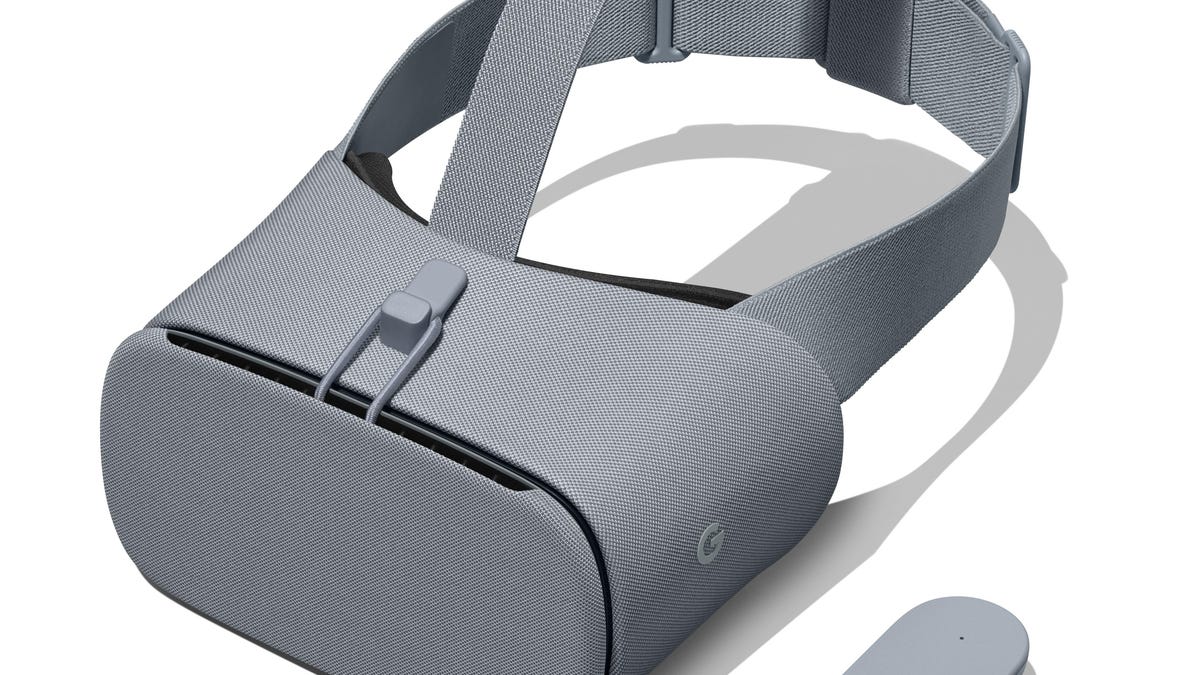Google Daydream View VR returns: This time it's comfier
Google's next wave of phone VR aims for a better fit for phones that support it.
Last year, we called Google 's $79, £69 or AU$119 Daydream View the easiest-to-use VR experience yet. It easily turned any of an increasing number of Android phones into a competent VR headset.
For 2017, Google isn't changing the formula all that much. The new $99, £99 or AU$149 Daydream View -- announced Wednesday and shipping Oct. 14 -- looks practically identical at a glance. But even though it costs $20 more than its predecessor, it's got enough subtle yet important changes that I might buy it instead!
Update, October 17: Read our in-progress review right here.
UK and Australian prices and availability weren't announced, but $99 converts to £75 or AU$125.
Before I give you my quick impressions, here are the basics:
What's a Daydream View?
It's a cushy, fabric-covered set of magnifying lenses that stretch your phone's screen across your field of vision, and uses its built-in sensors, to let specific Daydream VR apps transport you to other worlds. It comes with a simple motion controller that lets you point, swing a sword, cast a fishing rod and so on, and otherwise navigate in VR.
It's generally nowhere near as immersive as full-fat VR headsets like a PlayStation VR , Oculus Rift or HTC Vive , because you can't walk around or grab things with your hands, but it's way less expensive and easier to set up.
It only works with certain Daydream-certified Android phones, including the new Pixel 2 and Pixel 2 XL . Here's the full list.
More from Google's event
What's new for 2017?
According to Google's Daydream product managers (and I can largely confirm after a brief demo):
- Redesigned facepad distributes pressure more evenly on the face
- Revised straps fit more people and distribute weight more evenly
- New (optional, detachable) top strap adds stability
- New, larger lenses offer roughly 10-degree wider field of view
- The custom fresnel lenses also have a larger sweet spot (it's easier to get and keep VR images in focus)
- Better seal means less light leaks into the headset, particularly around the nose (the light can distract you from VR)
- New magnesium heatsink, in the lid, lets your phone run VR for longer without overheating
- Revised controller has more clearly defined buttons, easier to find without looking
- You now store the controller inside a fabric loop on the rear strap, instead of inside the lid
- Revised controller software is more accurate (update will come to original Daydream controller too)
- Three new colors: charcoal (black), fog (gray) and coral (reddish pink)
- Available in five new countries: Spain, Italy, France, Korea and Japan
I've gotta say, the differences in comfort were obvious the moment I put on the new headset. It's definitely still a little front-heavy, but it didn't dig into my cheekbones nearly as much as the original, and the top strap definitely helps. The lenses felt clearer, with less fiddling required to keep the image in focus, and it fit me better overall.
The fit, lenses, and straps have all been improved.
Google says it used its data center to run literally billions of optical simulations to help design these lenses, simulating 40 quadrillion rays of light -- calculations that would have taken 20,000 years on a single desktop computer, according to Google VR boss Clay Bavor. Plus, the company says it's tested the fit on over 700 real people so far.
The most interesting new idea is perhaps the magnesium heatsink, though, and it's the one I wasn't able to test during my brief demo. I've frequently found that phone-based VR headsets will make phones overheat, and last year's Daydream wasn't an exception to the rule. Google isn't promising it'll never happen if you, say, use it out in direct sunlight, but Bavor says the heatsink will significantly delay if not prevent overheating "in regular conditions."
In fact, Bavor says the new Pixel 2 and Pixel 2 XL phones were designed with this headset in mind, to the point the phones intentionally concentrate their heat on the rear casing, so the heatsink can do its job.
The new Coral color.
What's to do?
That's still the real question for any VR headset, especially Daydream. Google says Daydream now has 250 different apps, and it supports quite a few phones, but it's still a smaller platform than Samsung's Gear VR right now. YouTube, Google Street View and Cardboard Camera are pretty neat, but there's not a lot we consider a must-play in VR.
But as it did with Need for Speed, Gunjack 2 and Virtual Virtual Reality (which I recommend checking out), Google says it's still putting dollars towards more exclusive VR content. The items Google's currently promoting include a YouTube series called Austin City Limits Backstage that take you up close and personal with stars like Ed Sheeran (it looked pretty good in VR) and a comedy series called The Confessional that puts you into the priest's box to hear comedians like Trevor Noah dish out. "We'll be funding a lot more content in that realm," says Bavor.
Plus, Google says it's working to bring movies designed for Imax dome theaters to Daydream as well.
What about the phone-less VR headsets Google announced in May?
The official answer is: Stay tuned. Bavor says Google will talk more about standalone headsets, from partners such as Lenovo and HTC, later in the year.
For now, Google VR is all about phones.
Google Pixel 2: Hands-on with Google's new phone
Everything Google just announced: Every story from today's event


